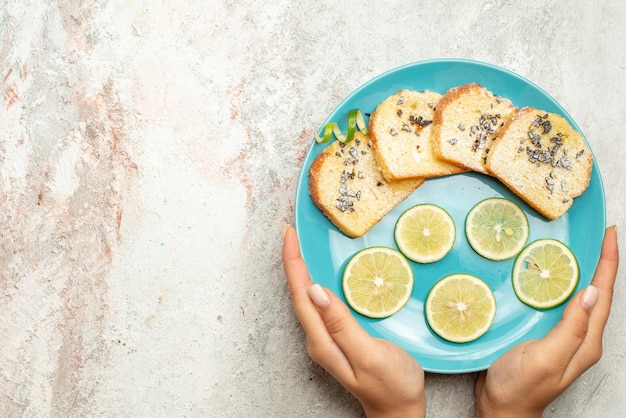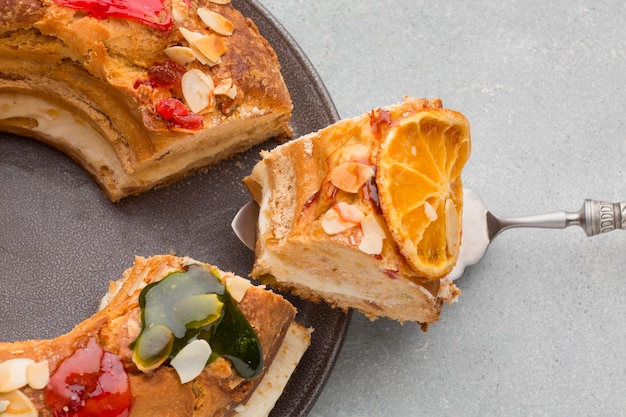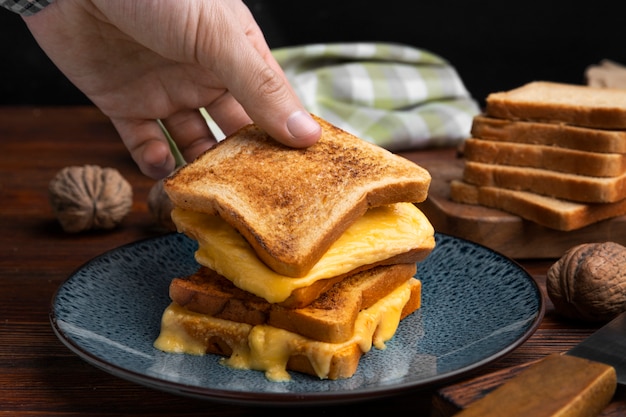(Part 1) The Foundation: Setting the Stage for Success

The Bread: Choosing the Perfect Canvas
Let’s talk about the foundation of our French toast masterpiece: the bread. It's not just any old loaf that will do, you know. The right bread is crucial for achieving that perfect texture, soaking up the custard just right without turning into a soggy mess.My go-to bread? Challah, hands down. It's got this incredible, slightly sweet, almost eggy flavour that complements the custard beautifully. Plus, its dense, slightly chewy texture holds up perfectly in the pan, making it less likely to fall apart.The Custard: A Symphony of Flavors
Now, onto the heart and soul of French toast – the custard. This is where you get to unleash your creativity and experiment with different flavour combinations. My personal favourite is a simple blend of eggs, milk, vanilla extract, and a pinch of cinnamon. It's classic for a reason, you know? The vanilla adds a touch of sweetness and warmth, while the cinnamon adds a subtle spice that lingers on the palate. But if you’re feeling adventurous, there are endless possibilities:- Citrusy Zing: A tablespoon of orange zest or a squeeze of lemon juice in the custard adds a bright, refreshing touch.
- Spice it Up: A pinch of nutmeg or cardamom brings a warming, festive flavour to your French toast.
- Chocolate Delights: Melt some dark chocolate into the custard for a decadent twist. It pairs perfectly with a dusting of powdered sugar and a drizzle of maple syrup.
- Nutty Goodness: A tablespoon of chopped nuts like almonds or pecans adds a delightful crunch and a nutty flavour to the custard.
The Non-Negotiables: Key Ingredients for Success
While the bread and custard are essential, there are a few non-negotiable ingredients that will elevate your French toast game:- Butter: The key to that crispy, golden brown crust. It adds a richness and flavour that’s simply irresistible.
- Oil: A small amount of oil in the pan prevents the butter from burning and ensures even cooking.
- Patience: This is a marathon, not a sprint. French toast takes time to cook properly. Rushing it will only result in a soggy, undercooked disappointment. Be patient, let it cook slowly, and you’ll be rewarded with a beautiful golden brown masterpiece.
(Part 2) The Art of Cooking: Mastering the Technique

The Heat is On: Finding the Perfect Temperature
Here’s where a lot of people go wrong. You need to find that sweet spot – the perfect temperature to cook the French toast quickly and evenly without burning it to a crisp.Aim for medium heat. The butter should sizzle gently when you add it to the pan, creating a faint wisp of smoke, but not a raging inferno. This tells you that the pan is ready to go.
The Flip: A Delicate Dance
Flipping French toast can be tricky, especially if you're working with thick slices. It’s a delicate dance, requiring a gentle touch and a steady hand.Wait until the bottom side is golden brown and slightly firm before flipping it over. Use a thin spatula to carefully slide underneath the French toast and lift it up. It should come away easily without sticking to the pan. If it’s still clinging on, give it another minute or two to cook a bit longer.
The Finish: A Touch of Sweetness
Once the French toast is cooked through and golden brown on both sides, it’s time for the grand finale! I like to drizzle a little maple syrup over the top, but feel free to unleash your inner artist. Add a dollop of whipped cream, a sprinkle of powdered sugar, a handful of fresh berries, or even a scoop of ice cream for a decadent touch.(Part 3) Troubleshooting: Solving Common French Toast Problems

The Soggy Dilemma: Avoiding a Mushy Mess
Ah, the dreaded soggy French toast. It’s a nightmare that haunts many a breakfast table. The culprit? Usually too much soaking time or a pan that isn't hot enough.Here’s how to prevent a soggy mess:
- Limit Soaking Time: Soak the bread in the custard for no more than 5 minutes. This gives the bread enough time to absorb the custard without becoming overly saturated.
- Heat is Key: Cook the French toast over medium heat. This ensures that it cooks through and develops that crispy crust. A lukewarm pan won't cut it.
The Burning Issue: Avoiding Charred Edges
Burnt edges. Another French toast nemesis. This happens when the pan is too hot or you leave the French toast cooking for too long.To avoid this:
- Keep an Eye on the Heat: Pre-heat your pan to medium heat. Keep a watchful eye on the French toast as it cooks. If the edges start to brown too quickly, reduce the heat slightly.
- Don't Overcook: Remove the French toast from the pan as soon as it's golden brown on both sides. Overcooking will lead to those dreaded charred edges.
The Sticking Situation: Preventing French Toast from Sticking
French toast has a tendency to stick to the pan, especially if it’s not cooked properly or if your non-stick pan needs a little TLC.Here’s how to avoid this sticky situation:
- Seasoned Cast Iron: A well-seasoned cast iron pan is your best friend when it comes to cooking French toast. It provides even heating and a naturally non-stick surface.
- Pre-heating Power: Always pre-heat your pan before adding the butter and oil. This ensures that the French toast cooks evenly and doesn’t stick.
- Butter and Oil: Don't be shy with the butter and oil. A thin layer will create a barrier between the French toast and the pan, preventing it from sticking.
(Part 4) Experimenting with Flavours: Adding a Personal Touch
While vanilla is a classic French toast flavour, don’t be afraid to break free from tradition and explore other flavour combinations. Let your creativity run wild!Here are a few ideas to get you started:
- Cinnamon and Maple: A classic pairing that’s always a crowd-pleaser. The sweetness of the maple syrup complements the warm spice of the cinnamon perfectly.
- Citrus Bliss: A squeeze of lemon or orange juice in the custard adds a refreshing, tangy twist. It's especially delicious with a dusting of powdered sugar.
- Spiced Up: Experiment with warm spices like nutmeg, cardamom, or even a touch of ginger for a complex, layered flavour profile.
- Chocolate Dreams: Melt some dark chocolate into the custard for a decadent touch. Serve it with a scoop of vanilla ice cream and a drizzle of chocolate sauce for a truly indulgent treat.
- Nutty Goodness: A tablespoon of chopped nuts like almonds, pecans, or walnuts adds a delightful crunch and a nutty flavour to the custard.
Bread Alternatives: Beyond Challah
While challah is a fantastic choice for French toast, it’s not the only bread that can stand up to the custard.Here are a few bread alternatives to explore:
- Brioche: Brioche is another rich, slightly sweet bread that works beautifully for French toast. It has a delicate, buttery flavour and a slightly crumbly texture that soaks up the custard beautifully.
- Sourdough: sourdough bread adds a tangy twist to the dish, which complements the sweetness of the custard. It's a delicious and sophisticated option.
- Croissants: For a truly decadent French toast experience, use croissants. The layers of buttery pastry will soak up the custard and create a heavenly texture. It's a perfect choice for a special occasion.
(Part 5) French Toast for Everyone: Adapting the Recipe for Dietary Needs
Gluten-Free French Toast: Making it Accessible for Everyone
Making French toast gluten-free is easier than you think. Simply swap out your regular bread for gluten-free bread. I recommend using a gluten-free bread specifically designed for French toast, as it will hold up better in the pan and absorb the custard evenly.Vegan French Toast: A Plant-Based Delight
For a vegan French toast, simply use plant-based milk and egg substitutes in the custard. You can also substitute the butter for vegan butter or coconut oil. There are many delicious vegan egg substitutes available these days, so don't be afraid to experiment!(Part 6) Beyond Breakfast: French Toast for Every Meal
French Toast for Brunch: A Weekend Staple
French toast is a classic brunch dish that everyone loves. It's perfect for lazy weekends or special occasions. Serve it alongside fruit, bacon, or sausage for a hearty and satisfying meal.French Toast for Dinner: A Sweet and Savoury Twist
Who says French toast has to be a breakfast dish? It can be a delightful dinner option too! For a savoury twist, try adding cheese, herbs, or spices to the custard. You can even serve it with a side of roasted vegetables or a salad for a complete meal.French Toast for Dessert: A Sweet Treat
French toast can even be a decadent dessert. Serve it with a scoop of ice cream, a drizzle of caramel sauce, and a sprinkle of cinnamon for a truly indulgent treat.(Part 7) French Toast Around the World: A Global Favourite
French toast is a beloved dish around the world, with each country putting its own unique spin on this classic breakfast treat.Here are a few examples:
| Country | Name | Unique Feature |
|---|---|---|
| France | Pain Perdu | Often served with a dusting of powdered sugar and a drizzle of maple syrup or honey. In some regions, they may also add a splash of orange blossom water for a fragrant touch. |
| Italy | Torta Fritta | Typically made with stale bread, soaked in milk, and fried in olive oil. It’s often served with a dusting of powdered sugar and a drizzle of honey or a sweet wine like Vin Santo. |
| Japan | French Toast | Often served with a sweet and savoury sauce, such as a honey-soy glaze or a custard-like cream sauce. It's sometimes served with a side of fruit, whipped cream, or even a sprinkle of matcha powder. |
| Spain | Torrijas | Similar to French toast, but often soaked in a mixture of milk, sugar, and cinnamon, and then fried in olive oil. It's typically served with a drizzle of honey or syrup. |
(Part 8) Mastering French Toast: Tips and Tricks
Here are a few tips and tricks to help you achieve French toast perfection:
- Don't Overcrowd the Pan: Cook the French toast in batches to ensure even cooking and prevent overcrowding. This will allow the French toast to cook properly and develop that crispy crust.
- Don't Press Down on the French Toast: Let the French toast cook undisturbed to avoid squishing it and preventing it from crisping up. Avoid using a spatula to press down on the French toast as it cooks. Let it cook naturally to ensure that it cooks evenly and develops that delicious crust.
- Use a Thermometer: If you want to be sure the French toast is cooked through, use a meat thermometer to check the internal temperature, which should be 165°F (74°C).
- Store Leftover French Toast: Leftover French toast can be stored in an airtight container in the refrigerator for up to 3 days. Reheat it in the oven or toaster oven until warmed through. It's also delicious cold, especially with a dollop of whipped cream or a drizzle of maple syrup.
- Get Creative with Toppings: Don't be afraid to experiment with different toppings. Fresh fruit, nuts, whipped cream, chocolate sauce, and even a sprinkle of cinnamon are all delicious additions.
FAQs
1. What is the best way to prevent French toast from sticking?
The best way to prevent French toast from sticking is to use a well-seasoned cast iron pan or a non-stick pan that is properly preheated. Also, use enough butter and oil in the pan to create a barrier between the French toast and the surface.
2. How long should I soak the bread in the custard?
You should soak the bread in the custard for no longer than 5 minutes. This allows the bread to absorb the custard without becoming too saturated. If you soak it for too long, it will become soggy and fall apart in the pan.
3. What is the best temperature to cook French toast?
The best temperature to cook French toast is medium heat. This allows the French toast to cook through and develop a crispy exterior without burning. If the pan is too hot, the French toast will burn on the outside before it has a chance to cook through. If the pan is too cold, the French toast will become soggy and greasy.
4. How do I know when French toast is done?
French toast is done when it is golden brown on both sides and slightly firm to the touch. You can also check the internal temperature with a meat thermometer, which should be 165°F (74°C). It should not be soft or mushy in the center. If you press on it gently, it should spring back slightly.
5. Can I make French toast ahead of time?
Yes, you can make French toast ahead of time. Simply prepare the French toast according to the recipe and store it in the refrigerator for up to 3 days. When ready to serve, reheat it in the oven or toaster oven until warmed through. It can also be served cold, with a dollop of whipped cream or a drizzle of maple syrup.
Remember, the most important thing is to have fun and experiment with different flavours and techniques to find what works best for you. Happy French toast making!Everyone is watching

Perfect Rice Every Time: The Ultimate Guide to Cooking Rice
Cooking TipsAs a self-proclaimed foodie, I've always been a bit obsessed with rice. It's the foundation of countless cuisi...

Prime Rib Roast Cooking Time Chart: Per Pound Guide
Cooking TipsPrime rib roast. Just the name conjures images of lavish dinners, crackling fires, and hearty laughter. It’s ...

The Ultimate Guide to Cooking Asparagus: Tips, Techniques, and Recipes
Cooking TipsAsparagus. The mere mention of this spring delicacy conjures up images of vibrant green spears, crisp and burs...

Ultimate Guide to Cooking the Perfect Thanksgiving Turkey
Cooking TipsThanksgiving. Just the word conjures up images of overflowing tables laden with delicious food, the scent of r...

How Long to Bake Potatoes in the Oven (Perfect Every Time)
Cooking TipsBaked potatoes are a staple in my kitchen. They're incredibly versatile, delicious, and surprisingly easy to m...
